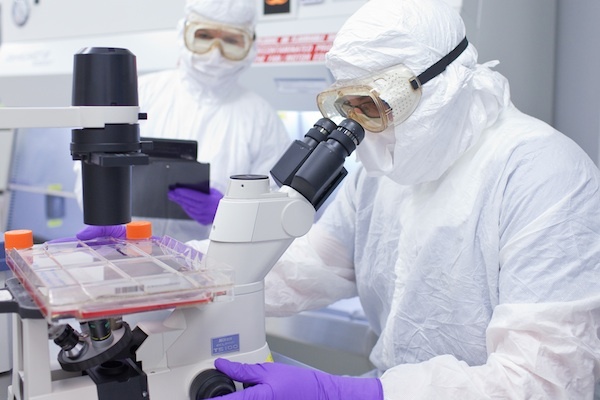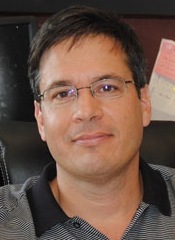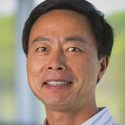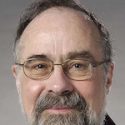Biomanufacturing center takes central role in developing stem-cell therapies

A Waisman Biomanufacturing specialist examines cells in a culture in the cell therapy clean room. The UW–Madison Waisman Center opened Waisman Biomanufacturing to ease the research and development of biological products and drugs.
Photo: Waisman Biomanufacturing
Developing a new drug takes enormous amounts of time, money and skill, but the bar is even higher for a promising stem-cell therapy. Many types of cells derived from these ultra-flexible parent cells are moving toward the market, but the very quality that makes stem cells so valuable also makes them a difficult source of therapeutics.
“The ability to form many types of specialized cells is at the essence of why we are so interested in stem cells, but this pluripotency is not always good,” says Derek Hei, director of Waisman Biomanufacturing, a facility in the Waisman Center at UW–Madison.
“The cells we can make from stem cells — cells for the heart, brain and liver — have amazing potential, but you can also end up with the wrong type of cell. If the cells are not fully differentiated, they can end up differentiating into the wrong cell type,” Hei says.

Derek Hei
Just like drugs, stem cells for clinical trials must be produced under a demanding regulatory regime called “good manufacturing practice,” he says. That capacity is rare in labs in private business and universities, and this is the only one at UW–Madison.
In June 2003, the Waisman Center opened Waisman Biomanufacturing to ease the research and development of biological products and drugs. The biomanufacturing facility is now deeply engaged in the business of stem cells.
One of the current projects of Waisman Biomanufacturing is a $1.8 million annual contract from the National Heart, Lung, and Blood Institute to grow stem cells into specialized cells such as neurons and retinal cells for research and clinical trials. This contract supports the research of a number of investigators at UW–Madison and beyond. For example, the stem cells are being tested in an animal model by UW–Madison cardiac surgeon Amish Raval, who is exploring how to rescue cardiac muscle cells following a heart attack.
For projects related to embryonic stem cells, Waisman Biomanufacturing collaborates with WiCell, a nonprofit organization established in Madison in 1999, to store and distribute stem cells. It also works with induced pluripotent stem (iPS) cells, which are grown from adult cells rather than embryonic cells. IPS cells for clinical use are based on cells differentiated by the Madison firm Cellular Dynamics International (CDI). “They have a really great technology for reprogramming stem cells, and we have the expertise to move what they are making toward clinical trials,” Hei says.
Developing a new drug takes enormous amounts of time, money and skill, but the bar is even higher for a promising stem-cell therapy.
Hei adds that one important goal of Waisman Biomanufacturing is to integrate the process of developing stem-cell therapies to encompass animal and human studies, while meeting Food and Drug Administration standards. “We are working to set up systems that are more efficient.”
Developing drugs and stem cells is expensive, and streamlining research and development benefits both the university and Wisconsin’s strong biotech industry, Hei says. “If you cannot make efficient use of investor dollars, companies will only be able to take one shot at a therapy, and they won’t have the capital for another run.”
One example of Waisman Biomanufacturing’s pivotal role emerges from a project with CDI and the Blood Center of Wisconsin that will identify “super-donors” — people who can donate cells that would be less likely to trigger an immune attack after transplant.
Cells derived from the super-donor stem cells will be tested by David Gamm, a pediatric ophthalmologist whose research lab is at the Waisman Center. Gamm wants to create “patches” containing retinal cells. “The idea would be to transplant the patch into the small area at the center of the retina that gives the most detailed vision,” Hei says.
“[Cellular Dynamics International has] a really great technology for reprogramming stem cells, and we have the expertise to move what they are making toward clinical trials.”
Derek Hei
Years of development remain for the patch idea but, ultimately, a patient with age-related macular degeneration could be matched with stem cells grown from a suitable super-donor.
Matching an off-the-shelf product to a patient is an important step toward consistency and cost reduction, Hei says. “Cost is a huge issue,” since developing a unique line of cells for a single patient can cost $30,000 or more. “It’s obviously important to drive the price down, that’s a key to making this mainstream, affordable health care.”
All the players in the super-donor project are in-state, Hei points out. “This is coming together, and it’s all within Wisconsin. When I came here 10 years ago, this would have sounded like science fiction, but now we are on the verge of doing it.”



